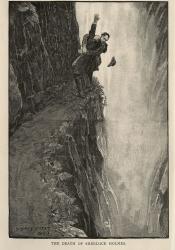The Death of The Detective
Sir Arthur Conan Doyle had no idea what he had stumbled upon when he initially wrote “A Study in Scarlett” in 1887. Though only moderately well-received upon first being published, the character of Sherlock Holmes exploded in popularity with continuing appearances. Doyle himself, however, quickly grew tired of the character. After a few short years, he was already done with writing him saying “I have had such an overdose of him that I feel towards him as I do towards paté de foie gras, of which I once ate too much, so that the name of it gives me a sickly feeling to this day.” Doyle believed that he was hindering his own writing pursuits by continuing the tales of Sherlock, so in 1893, he killed him. This event, which took place in the story “The Adventure of the Final Problem”, had Sherlock falling to his death after grappling with his mortal enemy James Moriarty. What Doyle hadn’t counted on, however, was how the public would handle the killing off of their beloved detective.
The backlash to this event was insane. It was reported that “More than 20,000 Strand readers cancelled their subscriptions, outraged by Holmes’ premature demise” and legend has it that “young men throughout London wore black mourning crêpes on their hats or around their arms for the month of Holmes’ death.” It was so bad that after eight years, Doyle relented and brought the character back, later going so far as to resurrect him in the world of the stories. This was an unprecedented reaction and showed us just how important media is for a lot of people. This was a very early showing of just how seriously fans take deaths and stories. This is something that is very commonplace today, but was rather uncommon back in the 19th century.
Sources: How Sherlock Holmes Changed the World. https://www.bbc.com/culture/article/20160106-how-sherlock-holmes-changed-the-world
When Arthur Conan Doyle Killed Sherlock Holmes. https://writingcooperative.com/when-arthur-conan-doyle-killed-sherlock-h...

